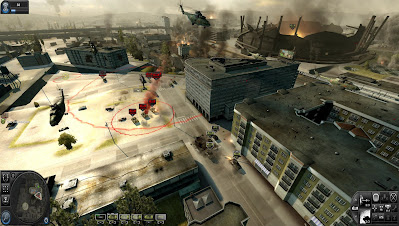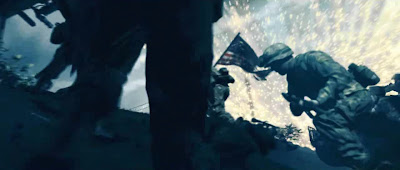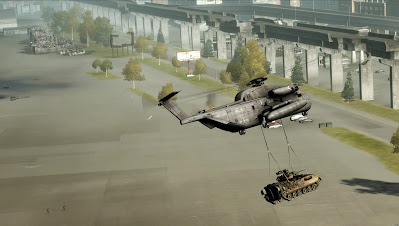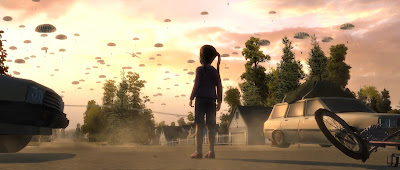What's the difference between strategy and tactics? Semantics? In video games, there is a difference between the two, which may become apparent in World in Conflict, an alternate history real-time tactics war game marketed and styled like a real-time strategy game.
You won't be base building or mining for resources here. There's just no time. A surprise invasion on American soil needs quick reactions and smart execution of orders as you use your environment as best you can to repel the Russian forces.
How long can your resistance hold out?
Fun Times
It was a normal day back in '89 when a bunch of cargo transports refused to identify themselves to the Seattle port authorities and then launched helicopter gunships to clear the skies for a landing force to set up and spread out.
The World in Conflict plot takes place across cutscenes, battle maps and paintings, and tells the tale of the Russians invading the United States for reasons as yet unknown, and the American's being caught completely unaware, scrambling around in a desperate effort to repel the invaders under some sort of structured defence can be established.
We're on the front lines in downtown Seattle, huddled behind sandbags, standing side by side with police officers and the National Guard. Of all the people here, we should be one of the more prepared for a situation like this. Should be...
We've played a fair few RTS games on this 1001 by now. Left-click to select units, right-click to move and target the enemy. There's nothing too difficult in controlling World in Conflict, and though it looks like the world has just gone to shit and hell has broken loose, it feels like a breeze to manoeuvre your meagre forces around the map.
They'll open fire when they spot a threat, and these vehicles are armed with TOW missiles that you can personally fire and target to demolish the enemy, before waiting patiently for the cooldown timer to reload another missile ready for you to use again.
You can make the argument that World in Conflict looks a little strange, it's cities both built up, but empty to allow for easier movement of units. This harbour isn't so much a bustling harbour, but a giant battlefield. You can zoom in to the action and reorient your camera to your liking, but still, World in Conflict looks weird, like you're playing with a bunch of micro machines or something.
It's a minor gripe because all this space is so that the graphics can shine with the explosive lighting and scale of the destruction that is too to follow.
With reinforcements incoming and the harbour locked down, we're been ordered to secure the Kingdome, where the civilizations are sheltering, looking for an evacuation. Naturally, the route there will take us through Russian forces, and, like Company of Heroes, the infantry in World in Conflict can hop into buildings to take cover and turn into temporary bunkers.
My infantry squads are huddled in the back of a transport vehicle or two - there's just no need to get them out and put them in danger right now - but we need a way to deal with these hunkered-down Russians.
At the top left of our screen, when available, we can call in air support in all shapes and sizes. Artillery strikes, laser-guided bombs, tank-busting strafe runs. If you've got the resources to pay for them, you can line your attacks up and watch the fireworks.
The Kingdome saved and the civilians loaded onto trucks and whisked away before it finally succumbs to the Russian assault, our first level of World in Conflict ends in victory. It was an introductory mission of course, but it was a taste of how this game will go - explosively, most likely.
The Russian invasion is relentless, and we're pushed back along key routes through Washington state, now being tasked with holding a bridge long enough for more civilians transports to escape across it.
An RTS would have us set up a base camp somewhere, build some factories to churn out vehicles, and barracks to train new recruits, but in World in Conflict, we've not got that luxury. The closest to base building we get is to take control of key points on the map long enough for some machine gun nests to be built.
I suppose in time we'll get access to stronger, more permanent defences, but the story so far seems like one of damage limitation and temporary footholds. With as many units as we can spare - helpfully reinforced by some friendly AI units - we can perform a final sweep of this area and shuttle some civilians off to safety.
From time to time you might expect to hop from one side of the map to the other to micromanage your forces, but World in Conflict takes you from one objective to the next so quickly that you're taken on a ride around the battlefield more than you are put in the big seat to command it all. Indeed, you're not the commander in chief, nor anywhere near it. You're the boots on the ground and need to follow orders. This bridge needs to be defended, no matter how dire the situation.
With the order to blow the bridge coming in, we're whisked to the other side of the bridge to set up another control point and make sure the Russians don't gain a foothold on either side - because they're airdropping their forces everywhere now.
We can do that too, though. At the top right of the screen, we can ask for airdrops where troops, tanks, and transports can be ordered and brought into play. Each has a points cost, and your available points are given to you at select points during a mission - remember, this isn't an RTS, we can't capture a building that generates resupply points. That's not how war works, is it?
So parachuting some more units in, we follow more orders to push out and defend a hospital, and, if there's time, to hinder the Russians in a secondary objective to reduce the likelihood of their airdrops. To be honest, I didn't pay much attention to the details.
There's no time to sit and deliberate about the best course of action in this game. There's no relying on steadily increasing resources to spawn new reinforcements. You've got to get the job done with the tools you're given, and you'll learn to appreciate every single tool you're given.
Not that I was playing cautiously or anything. I'm on the normal difficulty and haven't been decimated so far, despite an awful lot more Russians than allies. Maybe I'm just lucky. Maybe World in Conflict is still teaching me about all the cool stuff it has in its arsenal.
Three minutes of explosions later, and this skirmish has come to its end.
Final Word
After just two missions, I've seen enough of World in Conflict to know I'm going to be playing some more. It's scratching a similar itch to Company of Heroes, but the two games are quite different indeed, and not just because of the alternate history presented here, but in the gameplay itself.
It really does look and feel like an RTS, but all the logistics appear to have been stripped away from the player and given to the computer to dish out when appropriate. You don't have to worry about your back lines unless the story demands it. You don't have to hop across the map to manage multiple groups unless the story demands it. You don't need to sit and build up your forces before diving in, mostly because you can't because the story demands you keep moving.
I've read that such insistence of following story beats makes World in Conflict conflict with how well you're playing the game. You can be dominating the opposition forces, sweeping them aside as though they're made of paper, yet have a superior shout down the radio that it's time to retreat because the position is lost.
You can probably overlook little things like that because the game is fairly enjoyable. It's easy to get to grips with, with added complexity and options for those players who spot and make use of the opportunities, moving squads through buildings, calling in well-positioned airdrops, successfully timing a precious strafing run on a line of tanks.
I'll probably not be able to shake the feeling that I'm playing with micro machines rather than dictating the movements of armed forces on the front lines, and the characters I've met so far are forgettable, whether attempts have been made to make them relatable or not.
World in Conflict feels a little barebones in some places but smashes it in others. It's not going to wow everybody, but I do note that I've got the complete version, which includes missions from the Russian perspective, which might make the package doubly interesting.
I'm not expecting much from the plot, but I'll gladly be swept up in the action, overly elaborate though it may turn out to be. It's worth a try, especially for those of you who may have been put off by RTS games in the past. Maybe this is an entry into the genre, even if World in Conflict isn't really an example of one.
Eh. Semantics, right?
Fun Facts
The limited collector's edition of World in Conflict came with an authentic piece of the Berlin Wall.
World in Conflict, developed by Massive Entertainment, first released in 2007.
Version played: PC, 2007.













































